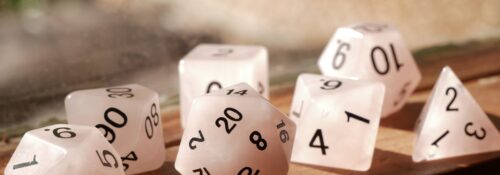
Rolling the Dice
Written by Katrin Surkan
They pause for air, each adventurer wounded but grinning at the conquest over the tentacled monster. One character, Ellarya, begins to search the room for clues, her smile fading with the adrenaline, as she notices that the children they had come in here to save are nowhere to be found. The rest of the party peels off one by one to pore over the walls until one of them shouts, “Found it!”
Welcome to Dungeons & Dragons (D&D)! Once I started playing the tabletop, role-playing game, I absolutely fell in love. Upon arriving at Hillsdale, I found myself one of many students who shared a passion for the camaraderie, adventure, laughter, and shenanigans that D&D inspired. Not only did it connect the student body, but I soon learned of games where professors joined in as well!
D&D is centered around a set of rules intended for a party of three to seven players—the main characters and plot drivers of the story—and one narrator, or Game Master (GM). Together, the party and GM spin a story of their joint adventures in a medieval fantasy world where magic lives (usually) and characters explore another world. D&D runs in sessions of varying numbers and frequency, ranging from a standalone game that occurs only once, to a weekly, multi-year campaign. The campaign continues until players no longer have the time to play or the story arc ends. Though playing is a blast, the best part is the connections that blossom from the shared experience. On Hillsdale College’s campus, I have found myself connecting frequently with people through the game, either by playing it or by trading stories with others who have played.
My history with Dungeons & Dragons on campus goes back to my time as a prospective student. As I wandered the dining hall, looking for a group to sit with, one young man’s d20 (a 20-sided-die) cap caught my eye. I could talk about that! The group welcomed me to the table, and one of them ended up dedicating her entire evening to showing me around the dorm and making me feel welcome. I still love meeting up with both of them.
As a freshman trying to connect with people on campus, I found D&D immensely helpful. Not only could I connect with upperclassmen through the game, where I had at least as much experience as they did, but I could also bring freshmen together to play and create friendships. Many of these people became my friends, and most of them still play.
Now, as a sophomore, I have built up a rather large repertoire of friends who play D&D on campus. When I seek to connect people within the larger Hillsdale community, I set up a game between them. I have become a kind of hub for connecting GMs and players. Multiple GMs looking to create a group have approached me, asking if I knew any players interested in a game. It has blossomed from a simple game into a community here on campus.
The game appeals to more than just the student body. I spoke with two faculty members who passionately discussed their characters and the game, explaining their love of “collaborative storytelling,” as one of them put it. “Can I respond to your question about why I love Dungeons & Dragons as my character?” one professor asked, passionate about her character. Through the game, players quickly grow fond of their characters and one another across ages and backgrounds, building a foundation in a world where everyone begins and works together that transfers over to the real world. One faculty game on campus represents five different departments, across both the sciences and humanities. Who would have thought that the empowerment of slaying dragons could connect our world, too?
D&D is not the only such game in production. There are a wide variety of systems set up in different times and ages (D&D is usually set in high-fantasy, medieval Europe), with different character power levels, and encouraging a variety of goals, from exploration to life simulation in a different age to political intrigue. Not only does it create and foster friendships between people, but the game also helps develop soft skills such as perseverance, leadership, and problem-solving, all within an atmosphere of teamwork.
Ellarya fumbles with the little keyhole in the wall, then steps aside to give Kaile a chance. He quickly picks the lock with a satisfying click! that reveals a huddled group of children in the fragment of light shed into the far corner. The four adventurers bring the huddle of kids safely back to the town and into the grateful arms of their parents, setting off soon thereafter to continue down the road. Not too far away, a moon rises over the peak of a tall fir tree, shedding light on a small, two-legged hut belonging to a leafy druid. The party hears a wolf’s howl off in the distance and turns to look at one another. With a nod, the four of them sprint toward it. Another adventure begins!
 Katrin Surkan, ’25, has roots on the east coast but can almost always be found traveling. When not writing, reading, or chatting with someone new, she’s likely looking for a dog to pet or singing at the top of her lungs between classes with a cappuccino in hand.
Katrin Surkan, ’25, has roots on the east coast but can almost always be found traveling. When not writing, reading, or chatting with someone new, she’s likely looking for a dog to pet or singing at the top of her lungs between classes with a cappuccino in hand.
Published in February 2023